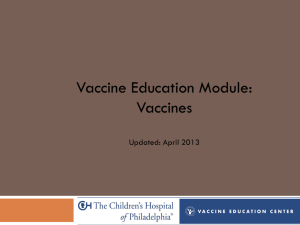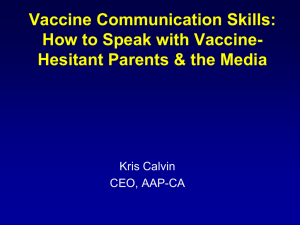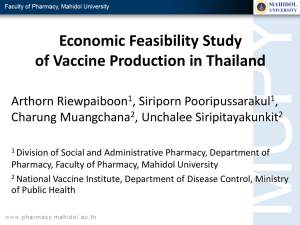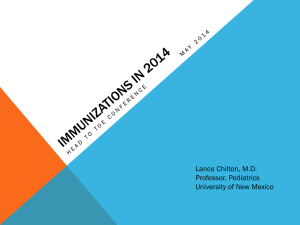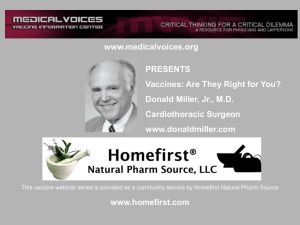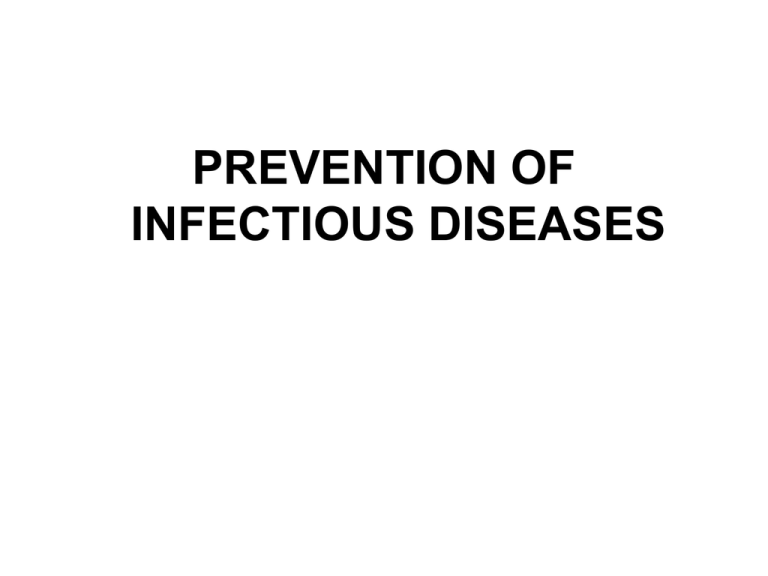
PREVENTION OF
INFECTIOUS DISEASES
Loughlin AM & Strathdee SA. Vaccines: past, present and future. In Infectious Disease
Epidemiology, 2nd ed, Jones & Bartlett, 2007; p 374.
Loughlin AM & Strathdee SA. Vaccines: past, present and future. In Infectious Disease
Epidemiology, 2nd ed, Jones & Bartlett, 2007; p 374.
Control Measures Applied to the Host:
Active Immunization
• vaccination is:
– the process of administration of an antigen.
• immunization is:
– the development of a specific immune
response.
Spring Quarter 2013 -Lecture 3
Principles of Control of Infectious Diseases
4
Principles of Vaccination (1)
•
•
•
•
Self vs. nonself
Protection from infectious disease
Response indicated by the presence of antibody
Very specific to a single organism
Principles of Vaccination (2)
Active immunity:
• Protection produced by the person’s own
immune system
• Usually permanent
Passive immunity:
• Protection transferred from another human or
animal
• Temporary protection that wanes with time
Principles of Vaccination (3)
Antigen
• A live or inactivated substance (e.g., protein,
polysaccharide) capable of producing an
immune response
Antibody:
• Protein molecules (immunoglobulin) produced
by B lymphocytes to help eliminate an antigen
Goldsby RA, Kindt TJ, Osborne BA.
Vaccines (chap 18). In Kuby
Immunology, 4th ed, 2000. W. H.
Freeman & Co, New York, NY; pp.
449-465.
Goldsby RA, Kindt TJ, Osborne
BA. Vaccines (chap 18). In Kuby
Immunology, 4th ed, 2000. W. H.
Freeman & Co, New York, NY;
pp. 449-465.
Types of Vaccines
Passive – injection of immunoglobulins, short immunity
Inactivated (killed) – limited immune response
DNA – Plasmid containing DNA that codes for desired antigen
Attenuated – large response and reversion to virulence
Recombinant – live or inactivated
Transvected – insertion of antigen into carrier (e.g., yeast)
Conjugate
Vector – insertion of gene into a carrier/vector agent
Toxoids – block toxin but not infection
Subunit – components of agent
Active Immunization:
Types of Antigens
• Inactivated toxins
– Diphtheria toxoid
– Tetanus toxoid
– Clostridium perfringens toxoid (pig bel
vaccine)
Active Immunization:
Types of Antigens (continued)
• Inactivated complex antigens.
– Whole cell pertussis vaccine
– Inactivated polio vaccine
– Influenza vaccine
Active Immunization:
Types of Antigens (continued)
• Purified antigens
– Acellular pertussis vaccine
– Polyvalent capsular polysaccharide
pneumococcal
– Polysaccharide meningococcal; proteinpolysaccharide conjugate Haemophilus
influenzae type b
– Plasma-derived hepatitis B vaccines
Active Immunization:
Types of Antigens (continued)
• Recombinant antigens
Hepatitis B recombinant vaccine is an
example of a vaccine composed of
hepatitis B surface antigen (HBsAg) subunits made through recombinant DNA
technology
Active Immunization:
Types of Antigens (continued)
• Live, attenuated vaccines
– Measles vaccine
– Oral polio vaccine
– Mumps vaccine
– Rubella vaccine
– Yellow fever
– Smallpox vaccine
– BCG (bacille Calmette-Guérin) vaccines
– Passage in cell lines
– Reversion to virulence
Active Immunization:
Types of Antigens (continued)
16
Goldsby RA, Kindt TJ, Osborne
BA. Vaccines (chap 18). In Kuby
Immunology, 4th ed, 2000. W. H.
Freeman & Co, New York, NY;
pp. 449-465.
Part 2 of Table 18.4
Goldsby RA, Kindt TJ, Osborne
BA. Vaccines (chap 18). In Kuby
Immunology, 4th ed, 2000. W. H.
Freeman & Co, New York, NY;
pp. 449-465.
Goldsby RA, Kindt TJ, Osborne BA. Vaccines (chap 18). In Kuby Immunology, 4th ed, 2000. W. H. Freeman
& Co, New York, NY; pp. 449-465.
Substrate to support virus
production; e.g., egg, HeLa
cells, etc.
Vaccine Additives
Antibiotics – prevent growth of contaminating bacteria
Aluminum gels/salts – adjuvant that stimulates a greater
immune response
Egg protein – vaccines prepared in eggs; not suitable for
allergic persons; e.g., most influenza vaccines
MSG – stabilizes vaccines against heat, light, acidity,
humidity
Thiomerosal – mercury-containing preservative
Vaccine Characteristics
Inactivated vaccines
Limited immune response
Immunity may wane over time
No secondary spread
Live vaccines
Replicate in vivo
Induce larger immune response
Induce immune memory/recall
Can revert to virulence
Can be secondarily transmitted to others
Routes of Administration
Intramuscular
Stimulates systemic immunity
May induce injection reactions
Subcutaneous
Oral
Easily administered
Induces gastric mucosal and systemic immunity
Nasal
Easily administered
Induces nasal mucosal and systemic immunity
Goldsby RA, Kindt TJ, Osborne BA. Vaccines (chap 18). In Kuby Immunology, 4th ed, 2000. W. H. Freeman
& Co, New York, NY; pp. 449-465.
Active Immunization:
Calculation of Vaccine Efficacy
• Formula for calculation of vaccine efficacy
(VE):
VE = Attack rate in Unvaccinated – Attack rate in Vaccinated
_____________________________________________
Attack rate in Unvaccinated
Active Immunization:
Herd Immunity
• Besides protection of the individual,
vaccination may also provide a degree of
community protection called herd immunity
• Herd immunity:
The relative protection of a population group
achieved by reducing or breaking the chains of
transmission of an infectious agent because
most of the population is resistant to infection
through immunization.
Active Immunization:
Herd Immunity (continued)
The mechanisms of herd immunity include:
– Direct protection of vaccinees against disease
or transmissible infection
– Indirect protection of nonrecipients by virtue of
surreptitious vaccination (e.g., spread of
attentuated vaccines), passive antibody, or
just reduced sources of transmission
– Level to achieve herd immunity depends on
infectiousness of agent
Evaluation of Vaccines (1)
Pre-clinical evaluation (animals)
Safety/toxicity
Biologic activity
Dose/route of administration
Phase I (small numbers of human volunteers)
Dose
Safety/toxicity
Biologic/immune response
Evaluation of Vaccines (2)
Phase 2 (50-100 human volunteers)
Safety/toxicity
Immune response (humoral and cell-mediated)
Demonstration of protection
Phase 3 (greater numbers of susceptible volunteers)
Requires study sites with adequate disease incidence
Requires vaccinated and control groups of susceptible
volunteers
Further evaluation of safety/toxicity
Provides estimate of level of efficacy
Evaluation of Vaccines (3)
Field trials (large populations of suceptible volunteers)
Large-scale double-blind efficacy trials
In different geographic areas
In different racial/ethnic/cultural groups
Observation of rare adverse/unusual reactions
Post licensing monitoring/surveillance (Vaccine Adverse
Event Reporting System (VAERS))
Case definition must recognize modified disease
Surveillance for rare adverse reactions and vaccine
failures
Population effectiveness (e.g., control/elimination/eradication)
Problems in scaling up coverage
Required Steps for Vaccine Approval (1 of 2)
Basic laboratory research
Preclinical – growth in tissue culture systems and animal
testing for immunogenicity and safety; challenge testing in
animals
Investigational New Drug (IND) application sponsor submits
proposal for testing in humans
Phase I – vaccine trials – test vaccine in 20-80 volunteers
for safety and immune response
Phase II – vaccine trials – test in several hundred volunteers
for safety, immunogenicity, dose, immunization schedule,
and method of delivery
Required Steps for Vaccine Approval (2 of 2)
Phase III – vaccine trial – test in thousands of volunteers;
randomized double-blinded using placebo and nature
challenge; look for unusual/rare adverse events
Biologics license application – approval by Food & Drug
Administration for labeling and public use
Phase IV – post-licensure monitoring for rare and
unexpected adverse outcomes
Vaccine Adverse Event Reporting System (VAERS); CDC –
voluntary reporting system for adverse events
Loughlin AM & Strathdee SA. Vaccines: past, present and future. In Infectious Disease
Epidemiology, 2nd ed, Jones & Bartlett, 2007; p 347.
Human Microbial Communities
(microbiota)
Human Microbial Communities
(microbiota) and Their Genes (1)
Number of cells in average human = 1014
Number of bacteria in average human = 1017
Ratio of bacteria: cells = >10:1
Percent of total body mass = 1-3%
+ viruses and fungi
Human Microbial Communities
(microbiota) and Their Genes (2)
Diversity:
The microbial community of each individual is
unique and constant (relative to betweenindividual diversity)
Components of microbial community within an
individual undergo constant changes
A few signature taxa dominate (= 17-84% of
total)
By ethnicity
Human Microbial Communities
(microbiota) and Their Genes (3)
The Human Microbiome Project Consortium. Structure, function and diversity of the healthy
human microbiome. Nature 486:209, 2012.
Factors that Disturb the Human
Microbial Community
Disturbants:
Oral antibiotics – gut, oral cavity
Oral antivirals – gut, oral cavity
Microbicides – contraceptives, condoms
Soap – skin
Invasive procedures – gut, respiratory system, vagina
Bacterial and viral infections – all systems
Diet
Epigenetics*
Restoration:
Fecal milkshakes (not sold by Baskin-Robbins), pills
*chemical changes to the genome that affect how DNA is packaged and
expressed without altering amino acid sequence
Human Microbiota Influences
Susceptibility to infectious diseases
Host response to infectious agents
Efficacy of antibiotics and antivirals
Susceptibility to chronic diseases
Manifestations and course of chronic diseases
Host response to treatment of chronic diseases
Twelve Tips to Prevent Infections
1. Wash hands frequently and sing “Happy Birthday”
2. Don’t share personal items (toothbrushes, towels, handkerchiefs, etc.)
3. Cover your mouth when you cough or sneeze
4. Get vaccinated
5. Use safe cooking practices (e.g., refrigeration to avoid food-borne
illnesses)
6. Be a smart traveler (e.g., safe drinking water, cooked food)
7. Practice safe sex (condoms)
8. Don’t pick your nose
9. Exercise caution with animals (zoonotic diseases) – sleep with people
not dogs
10. Watch the news (current outbreaks, Salmonella spread, etc.)
11. Practice healthy lifestyle (diet, exercise, habits)
12. Maintain beneficial microbiome





